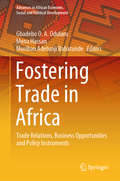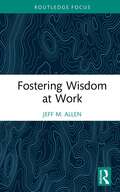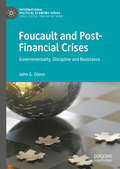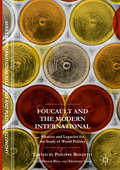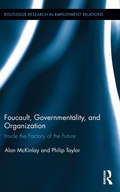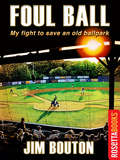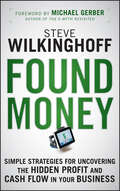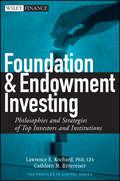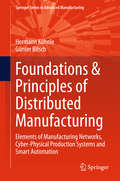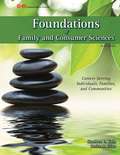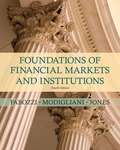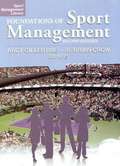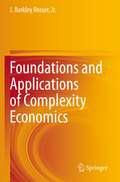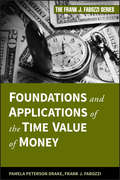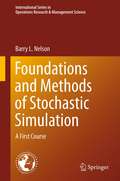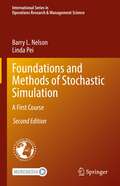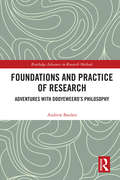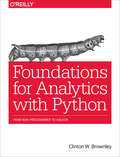- Table View
- List View
Fostering Trade in Africa: Trade Relations, Business Opportunities and Policy Instruments (Advances in African Economic, Social and Political Development)
by Gbadebo O. A. Odularu Mena Hassan Musibau Adetunji BabatundeThis book discusses trade relations and facilitation issues at both the regional and the continental African level, highlighting the increasing business opportunities and challenges that confront Africa in the digital age. It also examines the effects of trade policies and other policy instruments on Africa’s economic development and presents workable policy measures for a more business-friendly ecosystem. Discussing various topics, including trade relations between African countries, African and international trade agreements, and trade liberalization policies, the book appeals to scholars of economics, business and management as well as professionals and policymakers interested in fostering free trade and sustainable business development in Africa.
Fostering Wisdom at Work (Routledge Focus on Business and Management)
by Jeff M. AllenMost people can name dozens of knowledgeable people in their private and business lives, but highly value the very limited number deemed as wise. The fields of gerontology, psychology, and social science have attempted to study the phenomena of wisdom with little significant clarity or understanding of the construct within the expansive workforce development field. Wisdom, as an important aspect of a growing global knowledge economy, lacks the frameworks and theories needed for fostering workplace wisdom. This book brings a scholarly scrutiny to the study of wisdom, propelling the attribute to prominence within the broad field of workforce development and particularly within the growing context of a global knowledge economy. It investigates the characteristics of wisdom and offers theories, frameworks, techniques to foster wisdom in the workplace, recognizing it as a vital key to success for individuals and society. The ideal audience of this book includes senior learning specialists, organization development managers, HRD directors and workforce scholar-practitioners. These key individuals in organizations understand talent management and have a vested interest in the career construction of individuals in their organizations.
Foucault and Managerial Governmentality: Rethinking the Management of Populations, Organizations and Individuals (Routledge Studies in Management, Organizations and Society)
by Alan McKinlay Eric PezetIn the last two decades there has been an explosion of research inspired by Michel Foucault’s suggestion of a new concept, ‘governmentality’. The distinctive feature of modern governmentality is that across all sorts of fields, rule is predicated upon the active subject as the vehicle through which—and by which—power is exercised. The appeal of governmentality is that, whether we are considering the workplace, the school or welfare regimes, it opens up new ways of looking at familiar institutions. Foucault and Managerial Governmentality is about Michel Foucault’s concept of governmentality. The novelty of this concept is that looks at the ways that populations and organisations are imagined in ways that premise collective gains through expanding individual freedoms. Specifically, how are technologies of freedom devised that improve the overall performance—health, productivity, or parental responsibility—of a given population? Understanding the operation of technologies of control is a simple enough task, argues Foucault, but also one that blinds us to the increasing prevalence of technologies of freedom. Foucault and Managerial Governmentality aims not just to locate this concept in Foucault’s wider research project but to apply it to all sorts of management techniques. By applying governmentality to questions of management and organization we will also develop Foucault’s original, somewhat sketchy concept. This book has three innovative narratives: an awareness of the historicity of the concept; the application of governmentality to specific forms of management means that we escape the temptation to read any and all forms of technology and organization as an expression of neoliberalism; and, finally, the interviews with Peter Miller and Nikolas Rose provide unique intellectual and personal insights into the development of the governmentalist project over the last thirty years.
Foucault and Post-Financial Crises: Governmentality, Discipline and Resistance (International Political Economy Series)
by John G. GlennThis title explains the causes of the financial crisis and the economic reforms that were created subsequently through a Foucauldian philosophical lens. The author sets out the approaches established by Foucault – namely governmentality, biopolitics and disciplinary mechanisms – explaining how these influenced the shift of production from a local to a global level, alongside a shift towards financialisation. Glenn applies Foucauldian principles to aid understanding of the self-corrective mechanisms applied to the financial system, and the interpellative processes that led to the emergence of a new mode of subjectification. Concurrently, this title examines the retreat of the state from the financial sphere. This shift, the author posits, did not mean the complete absence of governance; rather governance became more concerned with ensuring that financial behaviour was contained within certain limits.
Foucault and the Modern International: Silences and Legacies for the Study of World Politics (The Sciences Po Series in International Relations and Political Economy)
by Philippe Bonditti, Didier Bigo and Frédéric GrosThis book addresses the possibilities of analyzing the modern international through the thought of Michel Foucault. The broad range of authors brought together in this volume question four of the most self-evident characteristics of our contemporary world-'international', 'neoliberal', 'biopolitical' and 'global'- and thus fill significant gaps in both international and Foucault studies. The chapters discuss what a Foucauldian perspective does or does not offer for understanding international phenomena while also questioning many appropriations of Foucault's work. This transdisciplinary volume will serve as a reference for both scholars and students of international relations, international political sociology, international political economy, political theory/philosophy and critical theory more generally.
Foucault, Governmentality, and Organization: Inside the Factory of the Future (Routledge Research in Employment Relations)
by Philip Taylor Alan McKinlayThis book traces how abstract managerial ideas about maximizing production flexibility and employee freedom were translated into concrete, day-to-day practices at the Motorola plant in East Kilbride, UK. Using eyewitness accounts, the book describes how employees dealt with the increased freedom Motorola promoted amongst its employees, how employees adapted to managerial changes, specifically the elimination of large-scale management, and where the ‘managerless’ system came under strain. This book will be of essential reading for researchers, graduate students, and undergraduates interested in the areas of management studies, human resource management, and organizational studies, among others.
Foucault, Management and Organization Theory: From Panopticon to Technologies of Self (Organization Studies)
by Ken P Starkey Professor Alan McKinlayThis volume draws together critical assessments of Michel Foucault's contribution to our understanding of the making and remaking of the modern organization. The volume provides a valuable summary of Foucault's contribution to organization theory, which also challenges the conventions of traditional organizational analysis. By applying Foucauldian concepts such as discipline, surveillance and power/knowledge, the authors shed new light on the genesis of the modern organization and raise fresh questions about organization theory. The bureaucratic career is, for example, analyzed as a disciplinary device, a mechanism that seeks to alter rational choice rather than constrain bodies. This raises questions about Foucault's linking of the modern organization's birth with the enlightenment. Other contributions review the impact of totalizing managerial discourses and the limits and possiblities of resistance, and question the profound pessimism of Foucault. The volume concludes by examining the implications of Foucault's later work in which he suggests that people are much freer than they feel.
Foul Ball: My Life And Hard Times Trying To Save An Old Ballpark (RosettaBooks Sports Classics)
by Jim BoutonA rollicking and &“compelling&” true story of baseball, big money, and small-town politics by the author of the classic Ball Four (Publishers Weekly). Host to organized baseball since 1892, Pittsfield, Massachusetts&’s Wahconah Park was soon to be abandoned by the owner of the Pittsfield Mets, who would move his team to a new stadium in another town—an all too familiar story. Enter former Yankee pitcher Jim Bouton and his partner with the best deal ever offered to a community: a locally owned professional baseball team and a privately restored city-owned ballpark at no cost to the taxpayers. The only people who didn&’t like Bouton's plan were the mayor, the mayor's hand-picked Parks Commissioners, a majority of the City Council, the only daily newspaper, the city&’s largest bank, its most powerful law firm, and a guy from General Electric. Everyone else—or approximately 98% of the citizens of Pittsfield—loved it. But the &“good old boys&” hated Bouton&’s plan because it would put a stake in the heart of a proposed $18.5 million baseball stadium—a new stadium that the citizens of Pittsfield had voted against three different times. In this riveting account, Bouton unmasks a mayor who brags that &“the fix is in,&” a newspaper that lies to its readers, and a government that operates out of a bar. But maybe the most incredible story is what happened after Foul Ball was published—a story in itself. Invited back by a new mayor, Bouton and his partner raise $1.2 million, help discover a document dating Pittsfield&’s baseball origins to 1791, and stage a vintage game that&’s broadcast live by ESPN-TV. Who could have guessed what would happen next? And that this time it would involve the Massachusetts Attorney General? &“An irresistible story whose outcome remains in doubt until the very end. Not just a funny book, but a patriotic one.&”—San Francisco Chronicle &“Bouton proves that a badly run city government can be just as dangerous—and just as hilarious—as a badly run baseball team.&”—Keith Olbermann
Foul Play in the Nonprofit Sector: Analyzing Corruption in US Charities
by Mark S. LeClairIt is quite easy to find corruption within nonprofits. This is particularly the case in the subsector of not-for-profits that are incorporated as traditional 501(c)(3) entities. With the continuing erosion of public confidence in charities, these institutions must act now, both individually and collectively, to bolster trust and ensure public support for nonprofits that has been a hallmark of American democracy. This book explores the causes of malfeasance in the nonprofit realm. It examines how the current inadequate regulatory environment—together with inherent “agency” problems—can lead organizations astray as they turn away from fulfilling donor wishes to instead act in their own self-interest. The book highlights the distinction between “soft corruption” in the nonprofit sector and “hard corruption.” The former includes the misuse of donor funds that do not cross the line into illegality and the latter covers explicitly illegal misappropriation of contributions. In Foul Play in the Nonprofit Sector, economist Mark S. LeClair provides constructive overviews regarding charity evaluation. Is it truly fair to judge nonprofits on their financials? The financial figures so frequently dictate the value of a nonprofit, and this often isn’t the best way to judge a charity’s performance. The manuscript includes suggestions for internal sectoral changes and regulatory reforms that can deter corruption at nonprofits.
Found Money: Simple Strategies for Uncovering the Hidden Profit and Cash Flow in Your Business
by Steve WilkinghoffAn accountant and consultant shows how to keep your small business on track for the long term—and maximize your moneymaking. If you&’re a small business owner, you probably started out with a great idea, an entrepreneurial dream, and the willingness to work as hard as you have to. You&’re up and running, your products and services are selling—but where do you go from here? How do you get there? And how can you be sure your business will make you money not just now but for the long term? Found Money presents a powerful new approach to small-business success. It helps you figure out, instantly, whether your business is on track or flying off the rails (and how to correct it if it is flying off the rails). Not only does it help you understand how your business makes you money, but how to control that process. It offers accessible, easy-to-use tools and tactics to help you understand the links between what happens in your small business and the financial results you achieve—so you can proactively create the financial results you want. By learning which customers to focus on; how to price your goods and services; how to test new ideas without excessive risk; and more, you can discover where additional profit and cash flow is hiding right now in your business. Includes a foreword by Michael Gerber, national bestselling author of The E-Myth Revisited
Foundation Course 1, Semester 2 , Revised Edition
by Vipan B. KumarThe main aim of this book is to make students aware of the various socio-economic issues that are important for our society and which directly and indirectly influence us.
Foundation Db2 and Python: Access Db2 with Module-Based API Examples Using Python
by W. David AshleyWork with Db2 to write SQL and access databases using optimized code for the fastest response. This book will give you complete documentation on DB2 via Python for the IBM_db module and provide a number of examples for the usage of each module API.Begin by getting your free version of Db2 for Linux and Windows. While the book concentrates more on the Linux version of Db2, it also covers enough of the Windows version so that you're comfortable with obtaining and installing Db2 on your version of Windows. Next, you'll see how to install the sample database that comes with Db2, and take some data from the web to design a database around it, including tables and indexes.For Db2 to be really useful you need to use strong SQL expressions. This book provides specific examples of how to avoid using poor ones that can cause extra processing time for the query. Lastly, you'll look at each API in the ibm_db and ibm_db_dbi module. This module is not sponsored by IBM and must be installed separately from the Db2 database.After reading Foundation Db2 and Python you'll be able to install Db2 on Windows or Linux, and perform backups and restore data. What You'll LearnObtain and install Db2 properly on Linux and WindowsCreate databases and load them on Db2Work with ibm_db and ibm_db_dbi API modules for PythonWrite SQL for Db2Review the future of the ibm_db Python module Who This Book Is ForPython programmers and DB2 administrators interested in building application with Python and DB2
Foundation and Endowment Investing
by Rittereiser Cathleen M. Kochard Lawrence E.In Foundation and Endowment Investing, authors Lawrence Kochard and Cathleen Rittereiser offer you a detailed look at this fascinating world and the strategies used to achieve success within it. Filled with in-depth insights and expert advice, this reliable resource profiles twelve of the most accomplished Chief Investment Officers within today's foundation and endowment community-chronicling their experiences, investment philosophies, and the challenges they face-and shares important lessons that can be used as you go about your own investment endeavors.
Foundation for Integrating Employee Health Activities for Active Duty Personnel in the Department of Defense
by Christopher Nelson Elizabeth M. Sloss Gary Cecchine Gail Fisher Preethi R. SamaThe authors describe current Department of Defense safety and occupational health programs and health information systems, as well as employee health programs outside of DoD to provide a foundation for considering a more integrated Department of Defense employee health program.
Foundational Research in Entrepreneurship Studies: Insightful Contributions And Future Pathways
by Golshan Javadian Vishal K. Gupta Dev K. Dutta Grace Chun Guo Arturo E. Osorio Banu Ozkazanc-PanThis book draws attention to the classic, seminal articles in entrepreneurship that have made profound contributions to the field’s emergence, development, and maturity. In each chapter, a classic is identified, ideas contained therein that are still relevant to the field are discussed, and subsequently follow-up research that is being conducted based on these ideas is highlighted, including possible areas of future research. Scholars will embrace this systematic effort to identify and reveal the contribution of classic articles in entrepreneurship research and their impact on subsequent scholarship.
Foundations & Principles of Distributed Manufacturing
by Hermann Kühnle Günter BitschThe book presents a coherent description of distributed manufacturing, providing a solid base for further research on the subject as well as smart implementations in companies. It provides a guide for those researching and working in a range of fields, such as smart manufacturing, cloud computing, RFID tracking, distributed automation, cyber physical production and global design anywhere, manufacture anywhere solutions. Foundations & Principles of Distributed Manufacturing anticipates future advances in the fields of embedded systems, the Internet of Things and cyber physical systems, outlining how adopting these innovations could rapidly bring about improvements in key performance indicators, which could in turn generate competition pressure by rendering successful business models obsolete. In laying the groundwork for powerful theoretical models, high standards for the homogeneity and soundness of the suggested setups are applied. The book especially elaborates on the upcoming competition in online manufacturing operations and respective control procedures. By outlining encapsulation and evolving decision-making principles, Foundations & Principles of Distributed Manufacturing fully conceptualizes the view of manufacturing networks as sets of loosely coupled interacting smart factory objects. Moreover, the book provides concrete approaches to a number of future fields, where distributed manufacturing might be applied. Both researchers and professionals will profit from the authors' broad experience in Distributed Manufacturing and Fractal Enterprise implementations, where they initiated and completed a number of successful research projects: within the global Intelligent Manufacturing Systems (IMS) scheme, within the European Research Area frameworks as well as national contexts, and both in industry and at leading research institutions. This background ensures well-founded theory on one hand and valuable practical results on the other in a fascinating area that is still under intensive research. Readers will acquire essential insights as well as useful guidance for categorizing and specifying extended distributed manufacturing solutions and their professional implementations.
Foundations Of Family And Consumer Sciences: Careers Serving Individuals, Families, And Communities
by Sharleen L. Kato Janice G. EliasFoundations of Family and Consumer Sciences a completely updated college-level textbook designed to introduce students to the Family and Consumer Sciences profession. An overview of the profession, including history and trends, is presented. Career opportunities for each Family and Consumer Sciences specialization area are explored and come to life in Professional Profiles and Issues in the News features. The text guides students in how to move into the workplace and make a difference in the lives of others.
Foundations Of Financial Markets And Institutions (Fourth Edition)
by Frank J. Fabozzi Frank J. Jones Franco P. ModiglianiA comprehensive exploration of the world's financial markets and institutions. Introduction; Financial Institutions, Financial Intermediaries, and Asset Management Firms; Depository Institutions: Activities and Characteristics; The U. S. Federal Reserve and the Creation of Money; Monetary Policy in the United States; Insurance Companies; Investment Companies and Exchange-Traded Funds; Pension Funds; Properties and Pricing of Financial Assets; The Level and Structure of Interest Rates; The Term Structure of Interest Rates; Risk/Return and Asset Pricing Models; Primary Markets and the Underwriting of Securities; Secondary Markets; Treasury and Agency Securities Markets; Municipal Securities Markets; Markets for Common Stock: The Basic Characteristics; Markets for Common Stock: Structure and Organization; Markets for Corporate Senior Instruments: I; Markets for Corporate Senior Instruments: II; The Markets for Bank Obligations; The Residential Mortgage Market; Residential Mortgage-Backed Securities Market; Market for Commercial Mortgage Loans and Commercial Mortgage-Backed Securities; Market for Asset-Backed Securities; Financial Futures Markets; Options Markets; Pricing of Futures and Options Contracts; The Applications of Futures and Options Contracts; OTC Interest Rate Derivatives: Forward Rate Agreements, Swaps, Caps, and Floors; Market for Credit Risk Transfer Vehicles: Credit Derivatives and Collateralized Debt Obligations; The Market for Foreign Exchange and Risk Control Instruments MARKET: Foundations of Financial Markets and Institutions, offers a comprehensive exploration of the revolutionary developments occurring in the world's financial markets and institutions -i. e. , innovation, globalization, and deregulation-with a focus on the actual practices of financial institutions, investors, and financial instruments.
Foundations Of Sport Management
by Andy Gillentine R. Brian CrowThe sport industry represents one of the largest and fastest growing industries in the United States and the world (Pitts & Stotlar, 2002; Sports Business Journal, 2003; The Sport Industry, 2007). This accelerated growth has fueled the continued desire of many people to pursue a career in the sport industry. Thousands of students each year, in the U.S. and abroad, enter academic programs specializing in the study of sport management to prepare for a future in sport.
Foundations and Applications of Complexity Economics
by J. Barkley Rosser, Jr.This book presents a survey of the aspects of economic complexity, with a focus on foundational, interdisciplinary ideas. The long-awaited follow up to his 2011 volume Complex Evolutionary Dynamics in Urban-Regional and Ecologic-Economic Systems: From Catastrophe to Chaos and Beyond, this volume draws together the threads of Rosser’s earlier work on complexity theory and its wide applications in economics and an expanded list of related disciplines. The book begins with a full account of the broader categories of complexity in economics--dynamic, computational, hierarchical, and structural--before shifting to more detailed analysis. The next two chapters address problems associated with computational complexity, especially those of computability, and discuss the Godel Incompleteness Theorem with a focus on reflexivity. The middle chapters discuss the relationship between entropy, econophysics, evolution, and economic complexity, respectively, with applications in urban and regional dynamics, ecological economics, general equilibrium theory, as well as financial market dynamics. The final chapter works to bring together these themes into a broader framework and expose some of the limits concerning analysis of deeper foundational issues.With applications in all disciplines characterized by interconnected nonlinear adaptive systems, this book is appropriate for graduate students, professors and practitioners in economics and related disciplines such as regional science, mathematics, physics, biology, environmental sciences, philosophy, and psychology.
Foundations and Applications of the Time Value of Money
by Drake Pamela Peterson Fabozzi Frank J.Comprehensive coverage of the time value of money In this book, authors Pamela Peterson Drake and Frank Fabozzi fully expand upon the type of time value of money (TVM) concepts usually presented as part of overviews given in other general finance books. Various TVM concepts and theories are discussed, with the authors offering many examples throughout each chapter that serve to reinforce the tools and techniques covered. Problems and detailed solutions-demonstrated using two different financial calculators, as well as Excel-are also provided at the end of each chapter, while glossary terms are provided in an appendix to familiarize you with basic terms. Provides the basic foundations of the time value of money Covers issues ranging from an introduction of financial mathematics to calculating present/future values and understanding loan amortization Contains problem/solution sets throughout, so you can test your knowledge of the topics discussed Understanding the time value of money is essential, and this reliable resource will help you gain a firm grasp of its many aspects and its real-world applications.
Foundations and Methods of Stochastic Simulation
by Barry NelsonThis graduate-level text covers modeling, programming and analysis of simulation experiments and provides a rigorous treatment of the foundations of simulation and why it works. It introduces object-oriented programming for simulation, covers both the probabilistic and statistical basis for simulation in a rigorous but accessible manner (providing all necessary background material); and provides a modern treatment of experiment design and analysis that goes beyond classical statistics. The book emphasizes essential foundations throughout, rather than providing a compendium of algorithms and theorems and prepares the reader to use simulation in research as well as practice. The book is a rigorous, but concise treatment, emphasizing lasting principles but also providing specific training in modeling, programming and analysis. In addition to teaching readers how to do simulation, it also prepares them to use simulation in their research; no other book does this. An online solutions manual for end of chapter exercises is also be provided.
Foundations and Methods of Stochastic Simulation: A First Course (International Series in Operations Research & Management Science #316)
by Barry L. Nelson Linda PeiThis graduate-level textbook covers modelling, programming and analysis of stochastic computer simulation experiments, including the mathematical and statistical foundations of simulation and why it works. The book is rigorous and complete, but concise and accessible, providing all necessary background material. Object-oriented programming of simulations is illustrated in Python, while the majority of the book is programming language independent. In addition to covering the foundations of simulation and simulation programming for applications, the text prepares readers to use simulation in their research. A solutions manual for end-of-chapter exercises is available for instructors.
Foundations and Practice of Research: Adventures with Dooyeweerd's Philosophy (Routledge Advances in Research Methods)
by Andrew BasdenMany of the issues on which meaningful research is founded are seldom discussed; for example, the role of everyday experience, diversity and coherence of meaning in the world, the meaningfulness and wider mandate of research, the very nature and validity of theoretical thought, and the deep presuppositions of philosophy and how they undermine the success of research. Such questions are material to the philosophies that guide research thinking in all fields, and since they cannot be satisfactorily addressed in a piecemeal fashion, this book employs the radically different philosophy of Herman Dooyeweerd to consider them together. Parts I and II discuss these issues theoretically and philosophically, while Part III discusses them practically, specifically the adventures that researchers across the world have had using Dooyeweerd's philosophy. Foundations and Practice of Research assembles a wide range of experiences of using Dooyeweerd's philosophy in research in the fields of mathematics, the natural sciences, the social sciences, design sciences and the humanities. Case studies demonstrate how Dooyeweerd's philosophy has been found fruitful in most stages of research, and the philosophical discussion backs this up. This book challenges researchers to join the adventures, including suggestions of potential research that could be carried out, as well as questions still left unanswered.
Foundations for Analytics with Python: From Non-Programmer to Hacker
by Clinton W. BrownleyIf you’re like many of Excel’s 750 million users, you want to do more with your data—like repeating similar analyses over hundreds of files, or combining data in many files for analysis at one time. This practical guide shows ambitious non-programmers how to automate and scale the processing and analysis of data in different formats—by using Python.After author Clinton Brownley takes you through Python basics, you’ll be able to write simple scripts for processing data in spreadsheets as well as databases. You’ll also learn how to use several Python modules for parsing files, grouping data, and producing statistics. No programming experience is necessary.Create and run your own Python scripts by learning basic syntaxUse Python’s csv module to read and parse CSV filesRead multiple Excel worksheets and workbooks with the xlrd modulePerform database operations in MySQL or with the mysqlclient moduleCreate Python applications to find specific records, group data, and parse text filesBuild statistical graphs and plots with matplotlib, pandas, ggplot, and seabornProduce summary statistics, and estimate regression and classification modelsSchedule your scripts to run automatically in both Windows and Mac environments
